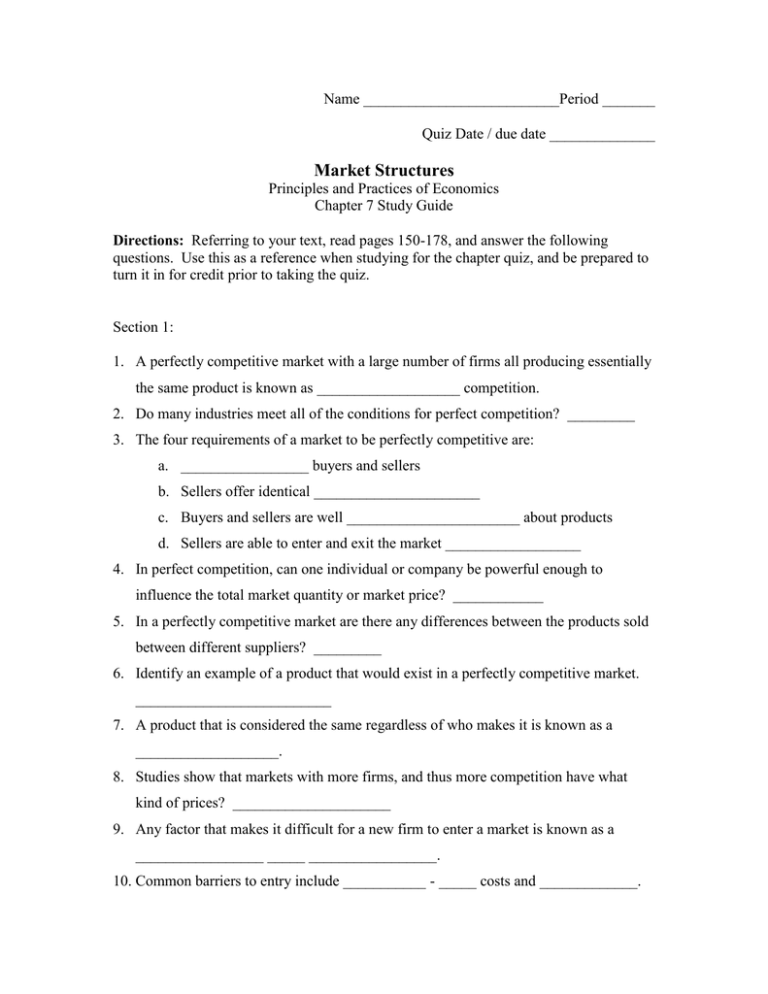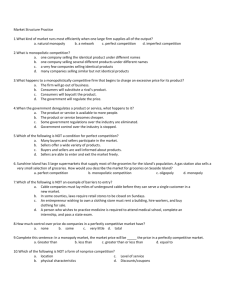Market Structures
advertisement

Name __________________________Period _______ Quiz Date / due date ______________ Market Structures Principles and Practices of Economics Chapter 7 Study Guide Directions: Referring to your text, read pages 150-178, and answer the following questions. Use this as a reference when studying for the chapter quiz, and be prepared to turn it in for credit prior to taking the quiz. Section 1: 1. A perfectly competitive market with a large number of firms all producing essentially the same product is known as ___________________ competition. 2. Do many industries meet all of the conditions for perfect competition? _________ 3. The four requirements of a market to be perfectly competitive are: a. _________________ buyers and sellers b. Sellers offer identical ______________________ c. Buyers and sellers are well _______________________ about products d. Sellers are able to enter and exit the market __________________ 4. In perfect competition, can one individual or company be powerful enough to influence the total market quantity or market price? ____________ 5. In a perfectly competitive market are there any differences between the products sold between different suppliers? _________ 6. Identify an example of a product that would exist in a perfectly competitive market. __________________________ 7. A product that is considered the same regardless of who makes it is known as a ___________________. 8. Studies show that markets with more firms, and thus more competition have what kind of prices? _____________________ 9. Any factor that makes it difficult for a new firm to enter a market is known as a _________________ _____ _________________. 10. Common barriers to entry include ___________ - _____ costs and _____________. 11. Expenses that a new business must pay before the first product reaches the consumer are called ___________ - ______ costs. Section 2: 12. When a single seller dominates a market, it is known as a _________________. 13. What is the principal condition that allows monopolies to exist? ____________________________________ 14. What is the problem with monopolies? 15. Factors that cause a producer’s average cost per unit to fall as output rises are known as ________________ _______ _______________. 16. A market that runs most efficiently when one larger firm provides all of the output is known as what kind of monopoly? _______________________ 17. What is an example of a natural monopoly? ________________________ 18. What must a firm with a natural monopoly do to be able to maintain the monopoly? ____________________________________________________________________ 19. When the government creates and regulates a monopoly, it is known as a _______________________ monopoly. (U.S. Postal Service is an example of this.) 20. When a company has exclusive rights to sell a new good or service for a specific period of time, they have a _____________________. 21. What do patents guarantee? 22. A contract issued by a local authority that gives a single firm the right to sell its goods within an exclusive market is known as a ___________________. 23. When a restaurant gives a senior citizen discount or runs a “kids eat for free” program, this practice is known as ______________ _______________________. 24. With price discrimination, companies can find the customers who need to good the most and charge them _____________ for that good. 25. For price discrimination to work, a market must meet the following three conditions: a. The company must have some market _________________, which means that it cannot be in a highly competitive market. b. The company must be able to divide the customers into distinct ___________ c. There must be difficult __________________ of the product or service. Price discrimination works best with goods or services that are consumed on the spot. Section 3: 26. In monopolistic competition, each firm hold a monopoly over its own ___________ 27. Monopolistically competitive firms sell goods that are similar enough to be substituted for each other, but are not _______________. 28. The four conditions of a monopolistic competition are: a. Many _______________ b. Few artificial barriers to _____________________ c. Slight control over _____________ d. Differentiated ____________________ 29. When products are made different from other similar products, this is called _______________________. 30. When the market competition is based upon things other than price such as physical characteristics, location, service level, advertising, etc. it is known as ____________________ competition. 31. If a monopolistically competitive firm started to earn profits well above their costs, the following two market trends would take those profits away: a. Competition would encourage rivals to thing of new ways to ______________ their products to lure customers back. b. New firms would enter the ______________________ 32. A market dominated by a few large, profitable firms is known as an ______________ 33. Two examples of oligopolies would be __________________ & ________________ 34. An agreement among members of an oligopoly to set prices and production levels is known as ___________________, which is illegal in the U.S. 35. An agreement among firms to sell at the same or very similar prices is known as ___________________ __________________. 36. An agreement by a formal organization of producers to coordinate prices and production is known as a ______________________, which is also illegal in the U.S.. Section 4: 37. When a company sells its product below cost to drive competitors out of the market, it is known as ____________________ pricing. 38. Laws passed to outlaw anticompetitive practices are known as what kind of laws? _______________________ 39. The combination of two or more companies into a single firm is known as a _________________ 40. Which two government organizations watch large firms closely to make sure they do not unfairly force its competitors out of the market? _______________ and 41. When the government steps back and no longer controls operating and pricing issues for an industry or company, it is known as ______________________. 42. What is the purpose of both deregulation and antitrust laws? ___________________ Read the chapter summary on page 178 carefully. Complete the Key Terms activity on page 178 by putting the correct answers in the lines below. 1. _____________________________________________ 2. _____________________________________________ 3. _____________________________________________ 4. _____________________________________________ 5. _____________________________________________ 6. _____________________________________________ 7. _____________________________________________






